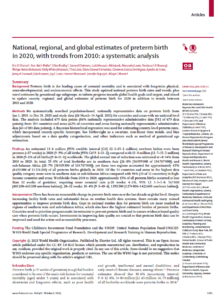
View Resource
Background
Preterm birth is the leading cause of neonatal mortality and is associated with long-term physical, neurodevelopmental, and socioeconomic effects. This study updated national preterm birth rates and trends, plus novel estimates by gestational age subgroups, to inform progress towards global health goals and targets, and aimed to update country, regional, and global estimates of preterm birth for 2020 in addition to trends between 2010 and 2020.
Methods
We systematically searched population-based, nationally representative data on preterm birth from Jan 1, 2010, to Dec 31, 2020 and study data (26 March–14 April, 2021) for countries and areas with no national-level data. The analysis included 679 data points (86% nationally representative administrative data [582 of 679 data points]) from 103 countries and areas (62% of countries and areas having nationally representative administrative data [64 of 103 data points]). A Bayesian hierarchical regression was used for estimating country-level preterm rates, which incoporated country-specific intercepts, low birthweight as a covariate, non-linear time trends, and bias adjustments based on a data quality categorisation, and other indicators such as method of gestational age estimation.
Findings
An estimated 13·4 million (95% credible interval [CrI] 12·3–15·2 million) newborn babies were born preterm (<37 weeks) in 2020 (9·9% of all births [95% CrI 9·1–11·2]) compared with 13·8 million (12·7–15·5 million) in 2010 (9·8% of all births [9·0–11·0]) worldwide. The global annual rate of reduction was estimated at –0·14% from 2010 to 2020. In total, 55·6% of total livebirths are in southern Asia (26·8% [36 099 000 of 134 767 000]) and sub-Saharan Africa (28·7% [38 819 300 of 134 767 000]), yet these two regions accounted for approximately 65% (8 692 000 of 13 376 200) of all preterm births globally in 2020. Of the 33 countries and areas in the highest data quality category, none were in southern Asia or sub-Saharan Africa compared with 94% (30 of 32 countries) in high-income countries and areas. Worldwide from 2010 to 2020, approximately 15% of all preterm births occurred at less than 32 weeks of gestation, requiring more neonatal care (<28 weeks: 4·2%, 95% CI 3·1–5·0, 567 800 [410 200–663 200 newborn babies]); 28–32 weeks: 10·4% [9·5–10·6], 1 392 500 [1 274 800–1 422 600 newborn babies]).
Interpretation
There has been no measurable change in preterm birth rates over the last decade at global level. Despite increasing facility birth rates and substantial focus on routine health data systems, there remain many missed opportunities to improve preterm birth data. Gaps in national routine data for preterm birth are most marked in regions of southern Asia and sub-Saharan Africa, which also have the highest estimated burden of preterm births. Countries need to prioritise programmatic investments to prevent preterm birth and to ensure evidence-based quality care when preterm birth occurs. Investments in improving data quality are crucial so that preterm birth data can be improved and used for action and accountability processes.